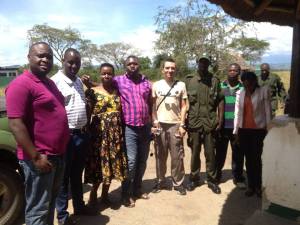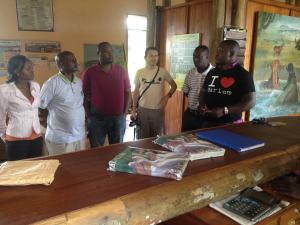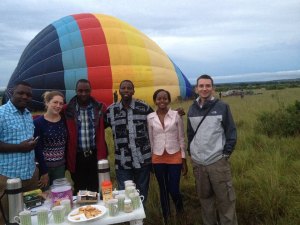Report visit Queen Elizabeth National Park 14/16 November 2014
Day 1 – 14 November
We went for a three days trip to Queen Elizabeth on 14th to 16th November 2014 under the arrangement made by the Uganda Wildlife Authority. AUTO was represented by Costantino Tessarin, Felex Musinguzi, Dona Tindyebwa, Rashid Kiyimba. The Uganda Wildlife Authority was represented by Stephen Masaba and Josephine Kalungi. We utilized two vehicles of the Uganda Wildlife Authority with the service of two drivers.
On day 1 the 14th November we left Kampala at around 8 to 9 am. We made stop overs at the Equator for a breakfast offered by UWA; then in Mbarara for lunch at Agip Motel.
By evening at around 5.30 am we reached Katunguru gate of Queen Elizabeth and we stopped for the first checking of the cashless system. At this gate, located along Kazinga Channel on the way to Mweya Safari Lodge, there is no loading system, but only the officer can verify what is loaded in the card and charge entry fees. We exchanged views with the operator asking about any inconvenience that could have happened at this entry point; he said that generally there were no inconvenient recorded here, only in some few occasions the card was reading the amount but the money could not be removed. All tour operators so far reach at this point when they already know that this is an entry- reading point, while the entry-loading points are only two: at Headquarter and Queen Pavillion. At Katunguru Gate we also met Mr. Nelson Guma the Chief Warden who welcomed us and agreed to meet with us on the following day. By this time we handed over to Mr. Stephen Masaba and to Mr. Nelson Guma copies of our write up with the concerns from tour operators about Queen Elizabeth National Park.
We proceeded along the route to Mweya Lodge following the Kazinga Channel, but we did not see animals, except some few elephants and a waterbuck.
By evening we checked in at Mweya Safari Lodge and agreed on the program of the following day.
Day 2 – 15 November
During breakfast, we interacted with Mr. Bill Perkins Senator of the New York State who was in Uganda in the occasion of ATA congress.
After breakfast at 9 am we visited the Visitor Information Center (VIC) near Mweya Lodge. Here we met Patrick Tushabe acting Tourism Warden and we inspected the cashless card system and verified that at this point tourists can only present their loaded card for making payment of various activities like game drives, boat trips on Kazinga Channel, entry fees to the national park. We discussed that being Mweya Peninsula a tourist Hub, it would be recommended to have here also a loading point, not only the reading point. Indeed there are clients arriving directly by airplane at Mweya airfield who have no access to any payment facility.
As a reaction, it was agreed that new entry points will be established, since there are new machines arriving. The new entry points will include: Mweya point VIC; Katokye Gate of Ishasha Sector. Concerning other national Park, there is still lack of an entry point at Ruhija sector of Bwindi and in Lake Mburo National Park.
After the VIC, we proceeded in the direction of Kasenyi and the game drives area. We first exited by Kabatoro Gate (along the road between Katwe and Main road) and reached Kasenyi Gate. Here we interacted with officer Grace and we also found our guide the ranger Robert Ntegeka. The gate is located along the road connecting to the fisherman village of Kasenyi and this poses a control problem as there are many people in transit trying to avoid the gate by passing from another nearby entry point and, still, claiming to be related to people of Kasenyi. This situation generates a level of uncertainty over the suitable control of tourists arrivals and security for this area of the park.
After taking a group pictures with the staff of the gate, we proceeded in the direction of Kasenyi, We stopped at Lake Bunyanpaka, the sald crater lake which has seen a recent development of construction of lodges and setting up of small handicraft shops and bars in the community land. We visited Kasenyi Safari Camp, a big investment on the shores of the Lake, still not completed, and where we interacted with staff and also realized how hot is this point of the park, debating if this is actually a good and recommended area for developing accommodation, being so hot and so near to the crater lake and especially near to the lions prides..
As we interacted with the UWA staff and the guide, we talked about the following topics: this area under the community land is not part of the National park, however it is important to have proper regulations in place to protect the image and the security of the national park, not to say from a conservation point of view, so that constructions development and human life are regulated; the local community of Kasenyi is now under the Local Government according to the new Wildlife Policy; there are about 4 lodges development in the same area around Lake Bunyanpaka; it has been noted that Lake George, the area on the shores where the community lives, is much polluted and need an overall check and control, yet this area is even a Ramsar site.
After visiting Lake Bunyanpaka, we proceeded visiting the UWA Headquarter. Here we had a meeting with Mr. Nelson Guma, Chief Warden (now called Conservation Area Manager). We explained to him that as AUTO we care for the future of Queen Elizabeth National Park and therefore we would like to have a dialogue with UWA concerning the status of the park and any possible exchange of views over the situation.
Nelson Guma expressed gratitude for the interest of the tour operators in the matter of conservation and tourism development of the park and he gave us a lot of general useful information.
1] He explained that Queen Elizabeth National Park is a “wildlife./ man biosphere reserve”, where human beings and wildlife co-exist together. The definition of biosphere reserve includes four aspects: conservation; livelihood of communities; research and economic development.
2] He discussed about the fishermen villages now called “wildlife sanctuaries” under the current law. These villages are 11 of which 2 are along Kazinga Channel. They definitely poses a threat to the work of UWA in conservation: in many villages people are rearing cows, which should not be the case, as this brings conflicts between wildlife and communities; there are many cases of poisoning traps which affect wildlife like elephants or lions; development is taking place in the community land which directly affect the national park, but over which UWA has no control. There is need to implement regulations over the Wildlife Sanctuaries and to engage the Local Government over a coordination of policies.
As a reaction on this topic, Rashid from AUTO suggested that UWA plans to buy all the private land and communities within Queen Elizabeth, one by one. This was seen as a good idea by all.
3] He discussed about the issue of the ‘lion tracking experience”, which faces a lot of criticism by tour operators as reported in our write up and he admitted that this is a tourist product that is not yet ready and needs regulations. He acknowledges that the experience of lions tracking must consider the following aspects in order to be successful: to limit the number of people assessing the activity in a day; to identify and limit the areas where the activity can take place; to identify conservation rules and regulations to avoid interfering with the lions life and avoiding that the activity could have negative impact on the conservation. The lions population of Queen Elizabeth Northern Sector is stable at around 140 lions. Also there have been for many years a specific research project for lions conservation and welfare, which is actually the basis from which the lions tracking experience was developed. All lions by now have a certain collar which helps monitoring them and intervene in case of accidents.
4] About the roads and traffic which is seen as a negative aspect affecting the Northern sector of Queen Elizabeth, Mr. Nelson Guma said that unfortunately the main road between Kasese and Katunguru is under the Uganda Road Authority, therefore UWA has no possibhility to control road kills, to enforce speed limits and to set check points for law enforcement. He suggests that this is a real issue to be considered and that it should be raised at the level of the Ministry of Tourism. Furthermore, he suggested that other specific roads only for tourists could be identified far from the main road.
As a reaction on this topic, it was said that definitely there must be a way forward to be able to control the access to this main road which traverses the park and which has a clear impact on the wildlife conservation. The issue of creating road passages for the wildlife was not discussed but it was in our write up.
5] The Chief Warden informed us about a serious threat that the national park is experiencing, which is the spreading of invasive weeds which are reducing the area available for the wildlife, like the lantern camara. These weeds are expanding at a very high speed, covering now a large area of the park and it is urgent to make a proper research and to implement a project for the removal of them. These weeds are spreading possibly due to various causes, including climatic change and change of wildlife habitat. Even the Southern sector of Ishasha is widely affected by this threat.
A follow up on this issue is necessary.
6] The Chief Warden explained about the positive impact of tourism revenues in the revenue-sharing mechanism with neighboring communities. He also advised a number of project investments where the communities near the park could benefit, like bee keeping, cage fishing and craft production.
There is a forum where all stakeholders can discuss and share views about Queen Elizabeth, which is called “Friends of Queen Elizabeth Forum” and he advised us to become part of it.
Day 3 – 16 November
Early morning at 5.30 am we drove from Mweya Safari Lodge to Lake Nyamunuka where we were booked for the Balloon Safari under the arrangement of Uganda Wildlife Authority. The Balloon Safari was organized with a team of one captain, another organizer (both from Egypt) and a working team of about five people. The setting took about one hour and at around 7 am we started the safari flying over the 2 surrounding crater lakes at a maximum altitude of about 600 meters. We spent about one hour on air, while the captain was able to maneuvers the balloon up and down as we were taking photographs. A part from our group of 5 people, there were other 3 people on board. At the end we landed and had a toast together and collected our certificate.
After breakfast, Patrick Tushabe showed us the new refurbished and renovated UWA bandas opposite Tembo Restaurant. At the moment UWA has a total of 40 beds, including 8 in self contained rooms. UWA took over the management of Tembo Restaurant and also these bandas, so that they can offer accommodation at the low level of the market, including domestic tourists, that level which tour operators are not investing in. Finally we also saw the self catering guest house, also managed by UWA and which can accommodate about 6 people.
After this visit, the trip was concluded with the return to Kampala by late afternoon.


